2011 Yamaha Phazer RTX Review
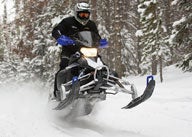
High-revving Phazer RTX redefined the lightweight trail sled niche
Anyone who has read our previous reviews of Yamaha’s Phazer trail sportsters knows, they have not been our favorites. The truth is that we expected too much and never quite forgave Yamaha for what we considered to be some shortcomings.
Engine Type:Parallel Twin
Cylinders:2
Engine Stroke:4-Stroke
Valve Configuration:OHV
Displacement:499 / 30.4
Starter:Electric
Turbocharged:No
View Full SpecWith the arrival of Ski-Doo’s new 600cc four-stroke powered TNT, we will cut Yamaha momentous slack. Up until now Yamaha’s Phazer, specifically the RTX, hasn’t had any serious competition. Yeah, yeah, there’s always been the fan-cooled and entry level carbureted 600cc two-stroke twins. But there hasn’t been a serious four-stroke challenger. Still, even now, the Ski-Doo TNT’s 600 ACE four-stroke twin lies at odds with the Yamaha Phazer twin in many ways.
Different Philosophies
While both may be four-stroke designs, their design philosophy differs significantly. The Ski-Doo measures nearly 600cc in overall displacement while the Yamaha settles in at 499cc. The Rotax-engineered and built twin delivers about 60 horsepower at 7250 rpm — traditional revs for a snowmobile engine. The Yamaha Phazer twin peak power arrives at the 12,000-rpm range, meaning it must use a gear reduction to get clutch speeds down to 8000 rev survivability range. The Ski-Doo Rotax twin was designed to maximize mileage. The Phazer twin seeks a sweet spot of high “smileage,” where sport, lightweight features and dirt bike handling come together. The fact is that both sleds hit their design targets. It’s just that the targets are different.
Nonetheless, the Ski-Doo 600 ACE-powered TNT does give the Yamaha a challenge and a choice among consumers looking for a fun-to-ride, lightweight, easy handling, and relatively low cost sport-oriented trail sled. And inadvertently, Ski-Doo’s 600 ACE helps to showcase the Phazer’s strengths.
Previous alternatives to the sporty Yamaha Phazer RTX have been standard-issue sport models powered by either a two-stroke fan-cooled engine or by a carbed low-end 600. The fan-cooleds gave you less power with similar weight to the Phazer while the 600s had more power and usually more weight. The new TNT 600 ACE is down on power to the Phazer but up in displacement. The weight issue should be close. And the price is actually lower on the Phazer.
Just don’t expect 29 miles per gallon from the Yamaha as claimed by Ski-Doo for its 600 ACE motor. Do expect superior top end and overall performance. The Yamaha Phazer RTX will out-accelerate and leave the TNT in its snow dust. That highlights the breeding differences between the two sleds.
Dirt Bike Heritage
The Phazer RTX Genesis motor reflects the high performance of Yamaha’s 250cc dirt bike engine from which it is derived. Like the larger Apex four-cylinder, the twin cylinder Phazer engine delivers peak power well past the typical 8000 revs of a typical snowmobile motor. Like the Apex quad, the Phazer features a gear reduction system to get maximum power-building revs down to 8000 rpm or so to allow the safe use of conventional primary and secondary clutch designs. The Phazer features Yamaha’s YVRC drive with a variable ratio driven.
The Phazer Genesis is a high tech design with three intake valves and two valves for the exhaust side. The intake side takes fuel from dual 43mm throttle bodies that are part of a very sophisticated electronic, computer-controlled fuel injection system.
The two-into-one exhaust exits the rear under the seat. This unique to Yamaha (and patented by Yamaha) exhaust position allows for a cooler running engine as exhaust heat is drawn out from under the hood, which also affords more efficient engine breathing as the exhaust stays cooler. Plus, it helps maintain better overall front to rear balance, which gives the sled better overall handling on the trail, especially in the twisties.
Play Rough
While the engine directly derives a bit of YZ250F dirt bike heritage, the overall philosophy behind the Phazer RTX borrows heavily from Yamaha’s dirt busters as well. It is light and lean with a narrow saddle, action-leveraged handlebar and wide floorboards that invites the rider to literally toss it around.
The Phazer FX chassis design approach reflects Yamaha’s dirt bike heritage. The frame is rigid with a diecast member and chromoly tube construction that deliberately requires a rider-forward sport position. The bars are mounted to bring the rider’s arms forward. But the steering leverage feels quick and easy, exactly what you need for quick transitioning in tight corner-to-corner action.
Premium Pieces
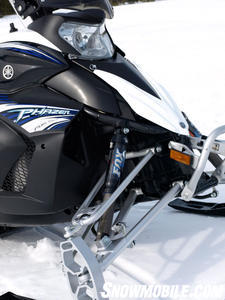 Yamaha’s Phazer RTX features premium Fox Float shocks to control 9.3-inches of travel.
Yamaha’s Phazer RTX features premium Fox Float shocks to control 9.3-inches of travel.
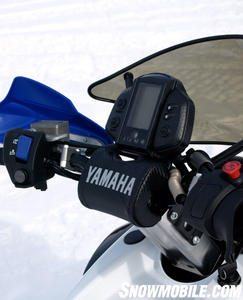 Speed is easy to read via Yamaha’s handlebar-mounted digital gauge.
Speed is easy to read via Yamaha’s handlebar-mounted digital gauge.
Because this is an 80-hp sled, you want to keep the power on. With a 150-hp Apex you can back off the throttle and regain momentum in an instant. Backing off of 80 ponies takes longer to reset the power charge. So, appreciate the action riding stance and the use of premium grade Fox Float front shocks on the double wishbone front end. The dual shock rear suspension features KYB aluminum shocks. When you hit rough sections, you’ll get full use of the sled’s 9.3-inches of front action and super-generous 16.2-inches of rear travel.
The track choice speaks to the Phazer RTX’s aggressive nature as well. It comes standard with a 121-inch circumference Camoplast Ripsaw design with action-grip one-inch lug height. Expect the 14-inch wide track to slip easily and quickly around corners, allowing more cornering quickness than you would expect from a modest 80-hp.
The aggressive features of the Phazer RTX run counter to the Ski-Doo TNT with 600 ACE power. Both are very much a blast to ride, but the Phazer has substantially more attitude. You’ll hear the Genesis wind up and tear off when you jam the throttle to the bar. The Ski-Doo will be more refined, giving you much less feedback sound or seat of the pants acceleration feel. You’ll treat corners differently as well. The more modestly outfitted Ski-Doo suspensions will handle sufficiently, but they won’t invite you to push the sled to the edge of its skis.
Ergonomic features are similar on both models, but the Phazer RTX offers a more aggressive “feel.” The digital gauge gives you an at-a-glance miles per hour readout. Both have electric start, reverse gear and handgrip warmers. But it will be the “naked” styling of the Yamaha that appeals to the action rider. The Phazer RTX is a bold statement that delivers a sport ride to match its sport style of long armed suspension pieces and low cut, racer-styled windscreen with bar end handguards.
When compared to the new Ski-Doo TNT 600 ACE, the 2011 Yamaha Phazer RTX shares similar pieces, but defines those pieces in a much more aggressive way. For US$8,499, the Phazer RTX gives you a bargain in performance snowmobiling. Is it faster? From our seat time, we’d say about 10 miles per hour faster than the TNT 600 ACE from about 20 more horsepower. Similar pieces they may have, but with totally different design and performance philosophies. You need to know which philosophy is yours. Both are excellent buys, but they are vastly different sleds overall.
| 2011 Yamaha Phazer RTX Specs | |
| Engine | Yamaha Genesis 80FI; 499cc, liquid-cooled twin cylinder with dual Keihin 43mm throttle bodies and electronic fuel injection; 5-valves per cylinder |
| Horsepower | 80 |
| Drive | Yamaha YVRC, variable ratio |
| Front Suspension | Yamaha double A-arm with Fox Float shocks and up to 9.3-in of travel |
| Rear Suspension | Yamaha Dual Shock CK parallel slide rail with C36 KYB aluminum shock on front arm and C40 HPG shock on rear arm; up to 16.2 inches of travel |
| Length | 111.0 in |
| Width | 47.0 in |
| Height | 46.8 in |
| Ski Stance | 42.7 in |
| Track | 14 x 121 x 1.0 Camoplast Ripsaw |
| Weight | N/A |
| Fuel Capacity | 7.0 US Gal (Regular fuel) |
| MSRP | US$8,499 — CDN$10,699 |
Related Reading
2011 Yamaha Snowmobile Lineup Preview
2011 Yamaha Apex SE Review
2009 Yamaha Phazer RTX Review
All Things Yamaha on Snowmobile.com



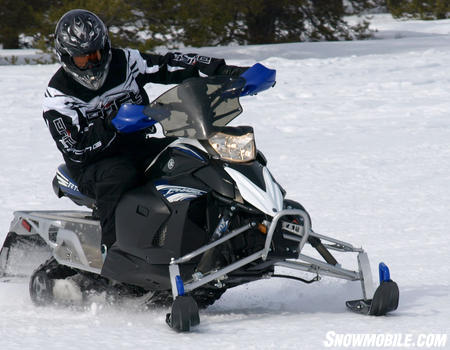
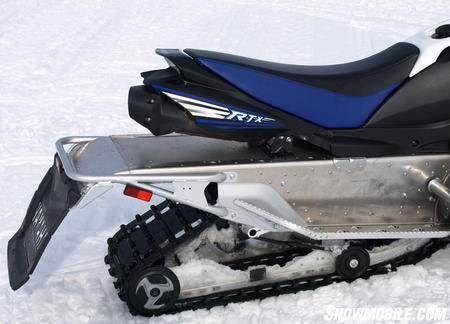
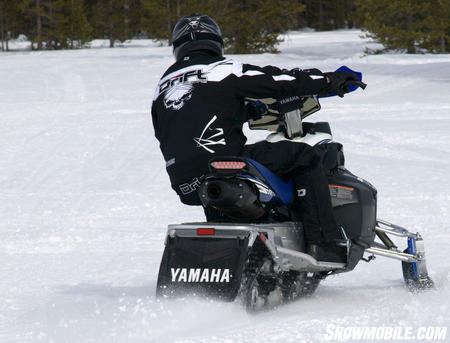





 Your Privacy Choices
Your Privacy Choices